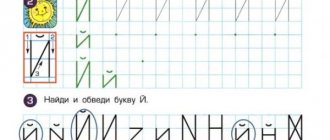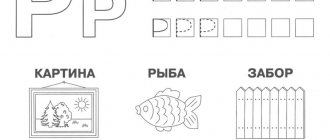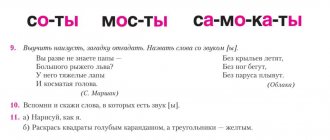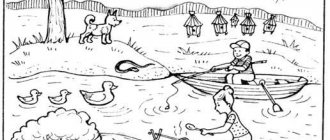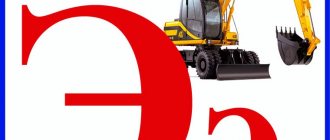Phonetic stories by T.A. Tkachenko. We teach you to pronounce the sound L correctly. The manual presents 15 stories and fairy tales, modified or compiled by a famous Moscow speech therapist-practitioner in order to automate the correct pronunciation for preschoolers and primary schoolchildren. All texts are equipped with special phonetic symbols, as well as color plot pictures that provide a visual basis for correcting sound pronunciation, developing lexical and grammatical concepts and coherent speech of children.
Unusual peg
Pavel planted a small apple tree in the garden. The trunk of the apple tree was thin - just like that, it would break. Pavel made a stake and stuck it in the ground near the apple tree. Pavel connected the weak trunk of the apple tree and the peg with a bandage. I tied up the apple tree and calmed down. All that was left was to wait for the green leaves.
Every day Pavel went to the apple tree and watered it. I watched the branches carefully. But there were still no green leaves!
One day Pavel saw from the window that his apple tree had finally turned green. When Pavel came closer, it turned out that it was on the peg, and not on the apple tree, that several green leaves appeared! “That’s a peg!” - Pavel thought.
Topic: “Sound [L]. Letter L"
Target:
- Introduce the sound [L] and the letter L.
Tasks:
Correctional and educational:
- clarification of the articulation of sound [L];
- development of phonemic hearing and perception;
- identifying a given sound by ear;
- compilation of sound characteristics;
- determining the location of sound in words;
- the use in speech of complex sentences with the meaning of opposition;
- the use of prepositional constructions of the instrumental case in speech; sound-letter analysis of the word “lama”;
- acquaintance with the letter L;
- learn to listen carefully to an adult’s speech, correctly understand logical and grammatical structures and answer questions;
Correctional and developmental:
- develop phonemic perception, visual attention, memory, thinking;
Correctional and educational:
- develop independence, perseverance, and the ability to work in a team.
Equipment:
- subject pictures; letter boxes, blue pencils, charts for reading syllables.
Progress of the lesson
Organizing time
Children stand near the speech therapist.
Speech therapist: Today I have prepared riddles for you, listen carefully, whoever guesses raises his hand. I will open the pictures of the answer on the board.
Puzzles
An angry grandfather sits in the ground. Dressed in a yellow fur coat, Whoever undresses him sheds tears. (ONION)
Lights up the way at night, doesn't let the stars sleep. Let everyone sleep, she has no time for sleep, There is light in the sky for us... (MOON)
Who is wearing a bright red beret, In a black satin cap? He doesn't look at me, He keeps knocking, knocking, knocking (WOODPECKER)
Four legs, seat and back. We are not horses, although everyone sits on us many times. (CHAIR)
I am the most energetic worker in the workshop, I beat as hard as I can all day long. (HAMMER)
It slips away like something alive, but I won’t let it go. It foams with white foam, I’m not too lazy to wash my hands. (SOAP)
L: Well done, and now I’ll say the guess words again, and I’ll highlight one sound with my voice. You should guess which sound I highlighted.
- Bow, moon, shovel, chair, hammer, soap.
Children - sound [L].
I. Introducing the sound [L]
1. Sound characteristics.
Speech therapist - listen to how this sound sounds - [l,,,l,,,l]. Now this sound will be uttered by Masha, Varya...
Tell me what sound it is - consonant, hard. Why did you decide so? (can’t sing, teeth and tongue get in the way)
L - that's right, now cover your ears with your palms and say the sound again. What else can you say about the sound [l]?
Children - he is loud.
L - if the sound is consonant, hard, then what sound symbol will we use to denote it?
D - blue circle.
2. L - and now let’s play the game “ Find the place of the sound in the word ” (using the guessing pictures) - name an object where the sound [L] is at the beginning of the word, in the middle of the word, at the end of the word. (There are diagrams on the board above words, and children post pictures under them)
Children line up in a circle.
3. L- Let's play the game “ Repeat without a mistake .” Development of phonemic hearing, pronunciation of syllable chains with vowel replacement (lo-lu-la...)
The children sit at the tables.
4. L - there are two pictures in front of you.
Didactic exercise “Find the difference”
Children compare objects: “In the first picture there is a boat, but in the second picture there is no boat.”
Didactic exercise “Find a place”
L - between what objects is the shovel located?
D - the shovel is located between the bow and the boat.
Physical education minute
(performing movements while speaking the text)
The flat boat floated; there were two oars in the boat. And the frogs on the oars swam merrily somewhere.
II. Introducing the letter L
L - what does the letter L look like?
Guess, look. Maybe it's a tick - Consists of sticks. The corner is the exact form, the letter stands exactly like this.
1. L - children, remind us how a sound differs from a letter!
(D - we hear and pronounce sounds, but we see and write the letter).
L - the letter L can be capitalized or small. Why is a capital letter needed?-
D - to write first name, last name, animal names, city name...
2. Reading reverse and forward syllables according to patterns . Reading syllables with a confluence (sla, slo, slu, sly, shla, shlo, shlu, shly)
3. Work at the cash registers.
L - you have the letters L on your tables, capital and small. Open the cash registers and move new residents into your apartment.
On the board there is a picture with the animal LAMA.
Laying out the word at the box office - LAMA, sound analysis of the word. Dividing a word into syllables.
L - how many sounds are in the first syllable, name the first syllable. How many sounds are in the second syllable, name the second syllable.
Laying out the syllabic pattern
Finger gymnastics “Here are the needles and pins”
Good Zlata
Zlata was sitting on a bench and eating a bun with sausage. A stray dog approached Zlata. She looked at the sausage, then at Zlata and whined quietly. It was clear from the dog's eyes that she had not eaten for a long time.
Zlata broke off half of the bun and gave it to the hungry dog. She ate everything instantly. Then the dog reached out to Zlata and began to affectionately lick her palms.
Strange Tangle
Klavdia Ivanovna was sitting on a bench and knitting. Her white cat was chasing pigeons.
Klavdia Ivanovna knitted and knitted and fell asleep. A ball of thread fell out of her palms and fell onto the sand.
The cat noticed the ball and began to roll it. Forgetting about the pigeons, the cat pushed and pushed the ball with its paws. The cat was having so much fun!.. At first the ball became very small, and then it was gone completely. The white cat searched for his ball for a long time.
How little Zlata became big
Little Ella really wanted to become big. She did everything for this! She put on my mother's high-heeled shoes. She curled her hair. She put beads around her neck. She even let her lips down with lipstick. But everyone in the house still called Ella baby.
One day Ella herself washed all the dishes in the kitchen and swept the floor. And then I made an omelette! And then suddenly dad said to mom: “Our Ella has become very big!”
Apparently, it’s not heels and lipstick that make people big!
The feasibility of speech therapy classes
Some parents do not think about how to teach their child to say the letter L. They do not consider the defect to be something serious, but in adult life it will become the basis of complexes and worries.
Important! It is better to correct speech disorders in preschool age, then the process will take a little time.
Explanatory and other types of speech as the level of development of a preschooler
If parents do not know how to correctly teach their child to pronounce the letters L and R, then they should contact a specialist. A speech therapist will be able to correct this problem and develop the desired pronunciation.
How many lessons does it take to produce sound [l]
It is impossible to say with certainty how many lessons will be required to eliminate the defect. Sometimes sound production takes one session, in other situations it will take more than 30-40 meetings.
It all depends on the characteristics of the child, his motivation and the interest of the parents. Learning to pronounce the sound [l] is not so easy, since a preschooler gets used to a certain stereotype. Due to their age, it is still difficult for children to perceive learning activities.
How does an individual sound production lesson work [l]
The speech therapist performs sound production only after the student performs articulatory gymnastics well. The complex is performed strictly in front of a mirror. Afterwards they do breathing exercises and perform speech hearing tasks.
How does an individual lesson on sound automation work [l]
The speech therapist conducts individual lessons on automating the sound [l] only after calling an isolated pronunciation. At such lessons, the specialist develops the lexical and grammatical structure of speech, phonetic and phonemic hearing.
To do this, use different games and simulators. Modern speech therapists use computer games. Parents are required to participate in the process and carry out the specialist’s tasks at home.
Important! The duration of the lesson for preschool age is approximately 25 minutes. Physical minutes are required to switch activities.
striped stick
Vladik walked with Polkan and constantly threw a stick at him. Polkan did not want to carry a stick. Then Vladik himself began to run after the stick. He knelt down, picked up a stick from the ground with his teeth and carried it to Polkan. Yes, studying was hard!
Once Vladik threw the stick especially far. Polkan was not seen for a long time. Finally, Vladik noticed that Polkan was carrying a stick in his teeth. The owner smiled contentedly. When Polkan came closer, Vlad saw in his mouth... a striped police baton!
Automation of sound [L] in independent speech
The introduction of a phoneme into independent speech is the final stage of automation. Here you also need to follow some rules. For a long time, the child is not able to control two things at the same time - what to say and how to say it. It is quite difficult to teach him to include self-control over pronunciation.
At first, only specially organized, slightly unnatural situations are considered independent speech. At first, only adults - parents and teachers - will control the correctness of sound pronunciation. They develop what is called a “guard reflex” in speech therapy, when an adult controls two aspects: organizes the conversation and corrects all articulation errors. To teach a child to use a new correct sound, after each erroneous pronunciation, give him a sample, achieving correct reproduction.
Typically, independent monitoring and correction of incorrect pronunciation begins approximately two weeks after the phoneme is set. Adults must emotionally reinforce the creation of a new articulatory stereotype. Full automation of a given phoneme lasts approximately one and a half months.
This period is relevant only for dislastic defects; with more severe defects, the automation period increases. To get a positive result, you need to practice every day for about twenty minutes and control the child’s speech in everyday activities.
Elk and woodpecker
The elk stood under the tree and looked at the Woodpecker. The woodpecker grabbed the trunk of the tree with its tenacious paws and deftly sat on its tail. He hollowed out the trunk and pecked out larvae and beetles from it.
“How are you, Woodpecker?” - exclaimed Elk standing under the tree. “Things are bad! - Woodpecker answered. - Jackdaw let me down. She promised not to occupy my hollow, but she did. She raised chicks in it. I was left without a home!
Elk, without thinking twice, said to Woodpecker: “Listen, gore Jackdaw.” And he started laughing. The Woodpecker understood the elk's cruel joke. After thinking, Woodpecker replied: “Not a bad idea! Just you, dear Elk, climb up my tree - together we’ll fly to Jackdaw!”
Automation of sound L
The formed pronunciation needs to be consolidated and pronounced constantly. If a preschooler does not know how to read, then pronunciation is reinforced by repeating it to the parents.
First, syllables are pronounced in which the consonant comes before the vowel: la, lo, le, li. Then, where the vowel comes first: ol, al, ate, il. After which they move on to pronouncing words where the consonant is at the beginning, middle and end, where the phoneme is softened and combined with other consonants.
Next, they practice the pronunciation of phrases and phrases where each word or most words contain syllables:
- straight lines - la, lu, lo, le, ly;
- reverse - al, ol, st, yl, ate, yul, yal, il;
- with joined consonants - cla, sla, bla, vla, pla, shla, gla, fla (similarly with the vowels “u”, “o” and “y”).
Making the sound L hard takes a lot of time. Usually you have to repeat the same words and phrases with children for several days.
When the phoneme in words and phrases has been worked out well, you can move on to rhymes, pure and tongue twisters, nursery rhymes, and riddles.
You can find a variety of speech therapy material on the Internet and bookstores. Texts must be spoken slowly and clearly, without distorting the sounds. If the pronunciation is incorrect, the sentence is repeated again.
If at the initial stage of reinforcement classes the patient repeats syllables, words, phrases after the speech therapist, then he must then independently remember and pronounce words and sentences. And the specialist only gives tasks:
- list the names of animals that include the phoneme being worked on;
- names of plants;
- names of food products;
- names of household items.
If the pronunciation of a hard phoneme is difficult, then you can start reinforcement lessons with soft syllables:
- straight lines - la, lyu, le, li;
- reverse - yal, yul, al, ol, spruce, ul, yl;
- with connected consonants - pli, ple, plu, plya (similarly with the consonants “s”, “f”, “k”, “g”).
Next, the soft phoneme, like the hard one, is fixed in words, phrases, and sentences. Pure twisters and tongue twisters, poems and riddles are used. Parents can compose pure sayings themselves together with their children.
Fun party
The last day of the year has arrived. Lyudmila was waiting for guests for dinner. How many things does a young housewife need to do?
First, she ran to the store, then washed all the dishes. Lyudmila installed a Christmas tree in the corner of the room and hung light bulbs on it.
“Just to make it in time for dinner!” - flashed through her head. Lyudmila baked a turkey in the oven, made several salads, and then put sweets and apples in a vase. All that remained was to put on a new dress.
The tired housewife lay down on the sofa for a minute... Lyudmila did not hear the calls.
When the New Year arrived, she slept soundly!
Articulation gymnastics for the sound L
It is the main stage of setting the sound L, carried out in stages. Classes, depending on the age of the patient, last from 15 to 25 minutes.
- Warm up. Move your tongue, imitating the clatter of horse hooves. The “Sail” exercise is also effective: the tongue rises vertically in the mouth, is held in this position for 10 seconds, with each session the holding time increases (maximum time - 40 seconds). Warm-up strengthens and makes the tongue muscles more mobile.
- From "Y". The game "Steamboat" is played. The mouth stretches into a smile, the tongue rests on the teeth. You need to bite the relaxed end of your tongue and say “y-y-y” or “oo-oo-oo.” It will turn out “l-l-l”.
- Setting from the soft sound “L”. It is easier for children to pronounce a soft phoneme than a hard one. After all, the labial muscles do not tense so much.
- From "A". You need to smile and, biting your relaxed tongue, pronounce a drawn-out “A”. It will come out “al-al-al.” Next there should be practice of “ala-ala-ala”, and at the last stage “la-la-la”.
- From "B". You need to teach your preschooler not to move his lower lip. He should hold the lower lip down for 5 seconds, then return it to the original position with the upper lip. If the patient cannot cope with the task on his own, then it is necessary to help him: put a finger under his lip, move it up and down.
Blue scarf
Mila bought a blue scarf. It was smooth, silky, with tassels - a sight to behold! —
Mila wanted to wear a headscarf to school. When Mila took the scarf from the shelf, it turned out to be wrinkled. Mila began to iron the scarf. But then, as luck would have it, the phone rang in the kitchen. Mila ran out of the room and left the iron on the scarf...
When Mila entered the room, she realized that her blue scarf was gone!
Reasons for incorrect pronunciation
Pronunciation may be incorrect or unformed because:
- the child is still too small to pronounce, simply skips the phoneme, says not “fox”, but “isa” (mastering the sound “L” occurs at about 4 years, recognition of hardness and softness – at 6 years);
- the tongue is placed incorrectly (interdental pronunciation is clear, but distorted);
- the tongue is lowered (bilabial pronunciation is typical for the English, often observed in children raised in interethnic families);
- the tongue is relaxed, and the lower lip actively moves ("B" appears).
In the cases described above, articulation is impaired due to a defect in the position of the tongue in the mouth. Also, a pronunciation defect is a consequence of the fact that a distorted air flow is formed due to the incorrect position of the end or middle of the tongue:
- the lips move when producing sound, not the tongue;
- the end of the speech organ descends rather than rests on the upper incisors;
- the middle of the tongue bends upward, and the end drops (normally it should be the other way around).
To correct the described defects of the articulatory apparatus, several sessions with a speech therapist are sufficient. But if the cause of distorted pronunciation is dysarthria caused by pathologies of the nervous system, then a systemic and multi-stage correction is required.
Bad thing
A small kitten was sitting on the steps at the entrance. Near him, with his head down, stood a large dog - a Dalmatian. The dog barked angrily at the kitten.
Not far away, on a bench, sat Vlad, the dog’s owner. He looked at his dog and smiled. The little kitten cowered and squeaked.
An elderly woman came out of the entrance. She picked up the kitten and commanded the dog: “Ugh! It is forbidden! Go away!" Then the woman came up to Vlad and said: “I found myself some fun! And aren’t you ashamed?” Vlad replied: “What? I did not do anything!" “That’s what’s bad!” - the woman remarked.
It's a pity!
It was summer. Volodya’s mother left home on business. She left her son some money and told him to go to the store. Volodya had to buy two packages of milk, two packs of butter and a package of sour cream.
Volodya took his bag and went to the store. He bought butter, sour cream and milk. When Volodya entered the entrance, the boys he knew called out to him: “Volodya, come out, let’s play football!”
Volodya flew into the kitchen, threw his bag on the floor and immediately ran out into the street. After half an hour in a warm place, without a refrigerator, the milk turned sour, the butter began to flow, and the sour cream became liquid and tasteless.
What a pity!
Sound correction [l] at home
Speech disorders occur for various reasons. In the case where the child does not speak only one or two sounds, parents can try to correct the defect themselves.
Classes with a speech therapist will help correct any speech problems
How to teach a child to say the letter L hard
With dyslalia, children have problems only with sound pronunciation. Violations arise due to structural features of the articulatory apparatus or insufficient muscle preparation.
For the sound [l], the upper rise of the tip of the tongue is important. This is difficult to do with a short hyoid frenulum. Therefore, it must first be trimmed by a dentist. Only surgery will solve this problem.
It’s easy to check the ligament: you need to ask the child to touch the upper teeth with the tip of his tongue. Sonoras ([l], [r] and their soft pairs) appear by the age of five and until that time there is nothing to worry about. At three years old, the child’s articulatory apparatus is still developing.
Important! There is no need to rush and demand that children pronounce all sounds from an early age. Otherwise, you can provoke the development of a defect.
At home, you can try to correct the incorrect pronunciation of the sound [l] yourself. This is only allowed in the case of dyslalia. Sometimes this problem can be confused with dysarthria, which requires work with a speech therapist.
With dysarthria, the mobility of the muscles of the articulatory apparatus is impaired. A similar problem is expressed in hypertonicity or hypotonicity. Often the tongue of such a child is bunched up in the mouth or is too relaxed. It will be difficult for your baby to perform fine movements and switch from one position to another.
Correcting incorrect pronunciation may take up to one year. You need to work with your child every day - this will speed up the process. It is necessary to follow the sequence of stages and not rush.
Sound production
The mechanical method is often used in speech therapy. It requires a special probe in the form of a wire frame or a spatula. The child opens his mouth wide, pronounces “YYYYYY” in a drawn-out manner, and at this time the adult lifts his tongue with an instrument.
It is easier to teach a child to pronounce a sound from the interdental position. To do this, the preschooler is asked to bite the tip of the tongue and pronounce the sound [s] (YYYYYYY), and then gradually remove the tongue behind the upper teeth.
You can pronounce [l] in the interdental position immediately with syllables. Gradually we are moving away from this situation. Automation begins only with direct syllables: LA, LO, LY, LE.
Important! You cannot rush to move on to words, otherwise defective pronunciation will become entrenched.
How to give speech therapy massage to a child at home
Sound Automation
After the correct pronunciation has been worked out in forward and backward syllables, they move on to words. To facilitate perception, visual material is used in the form of pictures and special games. For example, a child is asked to show objects with the sound [l].
Syllables can be pronounced using a probe
It is difficult to teach a preschooler to exercise self-control. Therefore, you need to constantly work with him. It is enough to devote less than half an hour to work and the effect will not be long in coming.
Parents should understand that there is no method that will give quick results. Only constant training will help you consolidate correct pronunciation.
Songs and rhymes
To facilitate the automation process, different lexical material is used. Pure sayings and poetic forms are easier to remember and the child likes to reproduce them.
You can talk to a preschooler about different topics. This will make it easier for him to get used to the correct pronunciation.
Example of poems for sound automation [l]
The main condition for effective classes is the interest of the student. Therefore, everything is carried out in a playful way. The more varied the material, the better for the baby.
Tongue Twisters
The most difficult thing is to introduce sound into independent speech. To facilitate the process, tongue twisters using the sound [L] are used. They contain words that allow you to practice sound pronunciation in different positions.
For example, “There are pins at the Christmas tree”, “Will in the field”, “I went to Luka’s tray, Luka bought onions from the tray”, etc. Gradually, the child is asked to pronounce each tongue twister faster. Much attention is paid to correct pronunciation.
Articulation exercises
Learning to pronounce a sound correctly begins with articulatory gymnastics. Speech therapy exercises for quickly setting sound [l]:
- The wide tongue lies behind the lower teeth, the child pronounces “YYYYYYYY” in a drawn-out manner.
- Lick your upper lip with the tip of your tongue.
- Click your tongue.
- Open your mouth wide and run your tongue along the inside of your teeth.
- Run the tip of your tongue across the roof of your mouth.
The complex is performed every day. In order for a child to learn to pronounce a sound correctly, he must do all the exercises correctly. In this case, it is important to monitor the immobility of the jaw.
Articulation gymnastics is performed strictly in front of a mirror
After all the movements are easy to perform, move on to the next stage - producing a solid sound [l]. To do this, different techniques are used. It is impossible to say in advance which one will suit a particular child.
